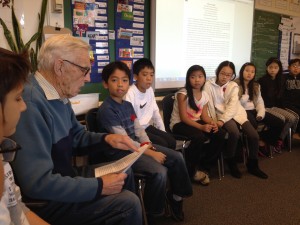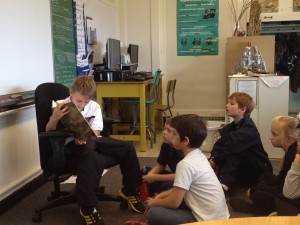Today we honoured Remembrance Day. We wore handmade poppies and heard a story from my grandfather, Trevor Harrop. My grandfather was about 12 years old and living in Scotland during World War II. I have grown up hearing stories about what it was like for my grandmother and him to grow up during the war.
My grandfather’s brother was in the war. He volunteered. My grandfather wrote a story in his honour and shared it with the class this morning.
“Lest we forget”
Far-called our navies melt away—
On dune and headland sinks the fire—
Lo, all our pomp of yesterday
Is one with Nineveh and Tyre!
Judge of the Nations, spare us yet,
Lest we forget—lest we forget![i]
On dune and headland sinks the fire—
Lo, all our pomp of yesterday
Is one with Nineveh and Tyre!
Judge of the Nations, spare us yet,
Lest we forget—lest we forget![i]
The 11th of November is Memorial Day throughout much of the world. It reminds us of the terrible events of conflicts and wars. They, in turn, remind us of those lost and those who served. Birthdays remind us of our friends and family. On occasions they are close enough to combine. Such is this story. While true, the details may be misplaced or out of order. I make no apologies. I, certainly, have a well-worn memory. But, still “We recall without repining, all the heat of bygone noon!”
Today is my brother’s ninetieth. Good for him. While people are living longer, he is above the norm. “Congratulations John and may you live to hear your hundredth”. Please note I said ‘hear’ because he is blind but this doesn’t deter him from living. He has the sharpest mind which allows him to have a fine conversation. And on occasion somewhat more than fine.
John worked in AB’s (Anderson and Boyce. An engineering firm in a suburb of Motherwell in Scotland that manufactured among other things, coal-cutting machines.) When the Second WW broke out in 1939 he was finishing his apprentice term of five years. All engineers at AB’s were exempt from military call-up or conscription. However, they could volunteer for service if so inclined. Haggs Reid worked in AB’s beside John and he volunteered for naval service. Some months later John volunteered too. And he too volunteered for the Royal Navy. Haggs was sent to Rossyth and John to Porstmouth for their preliminary training. As qualified engineers they were given officer status immediately. I do not know who and how their locations were decided but – but for the toss of a coin ‘there go I’. One went East and one went South.
After his induction to naval regulations, John was sent to Mombasa on the west coast of Africa a port that served the whole of Kenya. He went in a large troop ship as a part of a team of naval repairmen to the dockyards. This base served the whole of the Indian ocean. Shortly thereafter, his team was needed in Alexandria the major port for Egypt. They sailed up the Red Sea to the port of Suez at the south end of the canal. From there via railway to Alexandria, no luxury hotels in wartime, a tent city with troops for the Libya campaign . Following that stint, they were sent up the Persian Gulf to the island of Bahrain, then over to India and across to Sri Lanka (Ceylon in those days). Their posting was to the East Coast of Sri Lanka at Trincomalee. The harbor here was a huge lake with a small easily defended opening into the ocean. John remained in Ceylon for approximately six months when he was shipped back to Mombasa once more. Fortunately this repair crew never saw any hostile action. Finally after two years they were all shipped back to Portsmouth, then to Leith on the Firth of Forth where he was seconded to a minesweeper for duty on the North Sea. Billeted in this port, he managed many short weekend passes to our home in Motherwell. Minesweeping was a hazardous duty since they had to cut the mines anchor rode. When the mine floated to the surface, the crew took turns shooting at the activating cones on the mines thus blowing them to pieces. This assignment terminated John‘s service in the Royal Navy. Demobbed they called it!
Haggs Reid was visiting us after his induction. I can see him yet, sitting on one of the kitchen chairs in his full naval uniform wearing his skipped cap, white shirt and dark tie. He had fair hair and a healthy ruddy complexion which emphasized his white regular teeth. “I’m off to Murmansk tomorrow,” he said. We never saw him again but we learned later that the “Murmansk Run” was the most dangerous assignment of WW11 naval encounters.
When you think of these two sailors, you realize that somewhere a clerk was sitting at a desk and had a list of names before him. His job was to fill vacancies in crews. A toss of a coin! Of the thousands and thousands of vacant wartime positions to fill, your future was a small pen mark on a list! The short or long straw.
As a young boy of twelve, I adored my brother and still enjoy his company with brotherly love and respect. And yes, we will chat once more when we visit with him this coming holiday season.
You, too, can imagine that this story would never have been written if the pencil or pen ticks had been reversed.
Tjh ©
14-11-11
Following our assembly, DWF read us “The Enemy: A Book About Peace” by Davide Cali. Here is a YouTube reading of “The Enemy: A Book About Peace“.
I also found some great questions for you to think about when reading the book.



